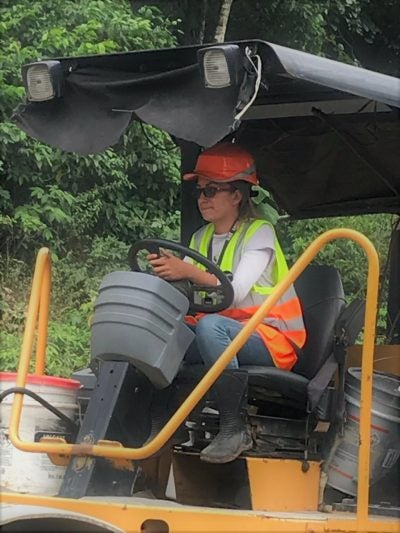These Boots were made for Working

Women in Unconventional jobs
According to data of INEC (National Institute of Statistics and Census), 68% of all men aged 15 and over are employed in Costa Rica, compared to 39% of women, proving that, despite all efforts to improve equal conditions for women at work, there remains a significant employment gap between women and men. This gap is more noticeable in women’s access to higher-paid and more stable skilled jobs, such as the operation of heavy machinery or engineers, among others, in the construction sector.
However, this Central American country has made great advances in education and economic development, which has improved the conditions for women to have access to all types of employment and, at the same time, has broken through barriers and stereotypes, both at the legal and the social level. This has led to a significant change in women’s access to, and availability and training for, unconventional jobs.
However, men continue to gain ground in traditionally female occupations, where 19% of employed men perform these tasks, as opposed to 12.7% of employed women in traditionally male jobs.
Construction of the Punta Norte highway, San Carlos, Costa Rica
The Punta Norte project (Design and Construction of the La Abundancia - Florencia and Radial Ciudad Quesada Highway, San Carlos Highway, National Route 35) is carried out with advanced construction techniques and is of great relevance to improve the conditions of economic activities in the area, which is highly productive, and the benefited population represents all social groups of the country. It must also be pointed out that canton San Carlos is in the 51st position in HDI (human development index) among all 81 cantons in the country.
It is interesting to note that, as part of the project mentioned above, women have a very high participation in supervising the work, they occupy positions such as Project Engineers, Administrative Engineers, Environmental Managers, Social and Occupational Safety Specialists. Working directly with the contractor on site, there are some positions held by women, from Assistant Project Engineer, to drivers of heavy equipment (such as a compactor and flag persons).
It is interesting to show how Viviam López, the driver of the project’s compactor, started performing this job. She told us that her husband drives a bulldozer, and that she was always next to him while he worked. It was him who suggested that she learn to drive the compactor, since it is always next to the bulldozer. It would give them a chance to work together, so he taught her himself. This story reflects how gender equality in Costa Rica is a process that starts from cultural change in women and men, and that is fundamental that both of them work together to achieve an increase in female employment in unconventional jobs.
Also the Assistant Project Engineer, Melissa Salas, monitors the progress of the project. This with all the challenges that come with the development of a work that is usually done by men and which is also oriented towards directing men. The reality of women in unconventional jobs is difficult but satisfactory, as it reveals that it is possible to generate the changes necessary for these type of jobs to become an option for women and become “conventional”, and for all of them stop being the exception.
The project also has women performing the tasks that they usually perform, such as administrative and similar positions, which implies a well-distributed female participation, although it is still low compared to that of men. The challenge is not only for companies to improve conditions and access to employment for women, but also to get women to feel willing to perform these tasks.
In Latin America, the employment situation of women has stagnated[5]. In jobs in construction, for instance, only 3% of the staff is female in the case of Costa Rica, and 4.7% all throughout Latin America[6]. In all transportation projects carried out by the IADB, work is being done to incorporate gender components that contribute to equal access and performance conditions for women and men, in both the development and implementation phases of the projects.
According to Infralatam data, the total investment in Costa Rica’s transport infrastructure sector was US$1,223.52 MM (2.33% of GDP) in 2015. The Ministry of Public Works and Transport (Ministerio de Obras Públicas y Transporte, MOPT), with funding from IADB, is about to develop major road infrastructure projects with the Transport Infrastructure Program (Programa de Infraestructura de Transporte, PIT), as well as nearly 200 projects to rehabilitate cantonal roads with the II Cantonal Road Network Program (Programa de Red Vial Cantonal II), where real job opportunities are presented for all those women who want to live the challenge of working in unconventional jobs.
Viviam López, compactor driver Punta Norte Project, San Carlos, Costa Rica
*Co-autor Mauricio Bayona.
Follow us on Twitter @BIDtransporte
 Login
Login

